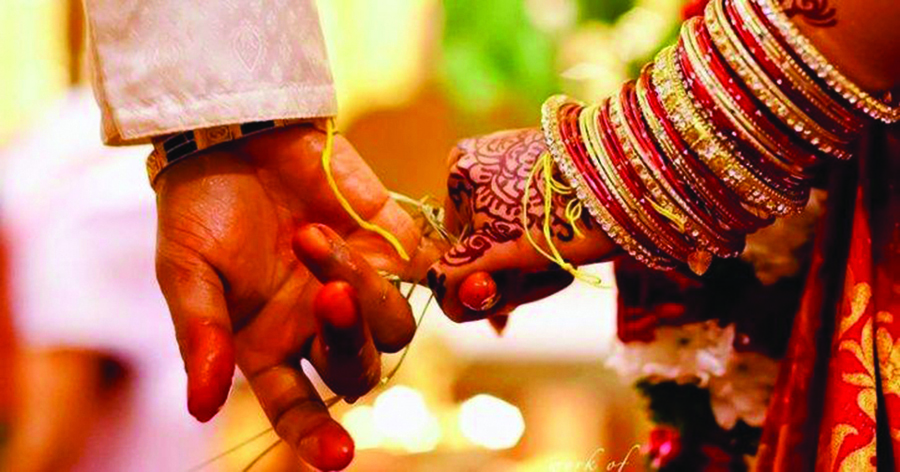
Before entering into any judgements or comments on this practice/tradition, we need to revisit the history that slowly revolved around the world and gave birth to this tradition. In simple terms, marriage is a cultural and legal union between two people often considered spouses (traditionally man and woman).
In a marriage, two people (husband and wife) come across a mutual understanding, trust and love for each other and both decide to spend their entire life together. In legal terms, it is associated with various elements such as legal age, consent, and degrees of relationship.
In many societies, it is also considered a culture of officially permitting sexual relations between the married husband and wife. Married couples give birth to children and raise a family of their own and this cycle continued from the past, is still continuing and will surely continue in the future.
Marriage is considered an advanced practice that maintains social stability, economic growth and enhances cultural continuity, leading to a proper civilisation. These are the most common understandings that most of us have about marriage. Marriage also involves compromises and hurdles that the two people concluding it have to face.
Broadly, marriage often leads the couple to spend their life together in a particular residence be it any as suggested by its definition and rationality. The definition has never categorised about whose residence it should be or should not be.
But culturally, in most cultures, the official residence after marriage where the couple is expected to live together is the husband’s residence. In simple terms, after marriage, the woman has to leave her actual home (her parent’s home) and shift to her husband’s home shifting all her possessions, even her family. And this practice is often considered a mandatory move or say compulsory tradition. People have been following it for ages and to date the practice is still prevalent in many of the cultures around the world.
This practice known as patrilocal residence has a traditional history. The practice of relocating a woman to her man’s home post-marriage has its history in agrarian societies where familial land and property were top-tier.
Background on women residing at men’s residences after marriage
In these times, men were often the primary inheritors and custodians of family assets, thus necessitating the integration of the bride into the groom’s household to consolidate the economy making sure that the lineage continues. This system forwarded the male dominance and underscored women’s roles as caretakers and homemakers, and generally a weaker section reinforcing the societal hierarchy.
Additionally, dowries and bridal gifts, prevalent in various cultures, symbolised the transfer of a woman’s familial allegiance to her new family which is her husband’s family. Over centuries, this tradition became entrenched, shaping gender roles and marital expectations across diverse civilisations, that echoed the complex phenomenon and familial dynamics that governed historical societies.
In Hinduism, the Vedic culture carries the significance of “kanyadan” where a daughter’s father handovers his daughter to her man shifting all the responsibilities he had for his daughter. It is expected that now the caretaker is her husband. This could also be categorised as a reason, the daughters had to leave their family and residence to adapt to a new family and residence.
Similarly, the emergence of the concept of feminine and masculine also justifies this practice. The feminine energy is often considered soft, flexible and more adaptable to changes than the masculine energy which is why women were expected to leave and shift after marriage so that they could easily adapt.
There could be other reasons for this expectation such as men were the breadwinners of the family, the primary source of economy and power or the dominant ones. Thus women dependent on men had to live in their residences leaving their parents’ residences after marriage. Different philosophies have their own justification that it was a reasonable move or practice at that period.
Yes, it was indeed a reasonable move or an acceptable practice at that time when the reality rounded around the dependence of a woman towards her father before marriage, towards her husband post marriage and towards her son in her senior years.
Although this practice was considered sensible and was justified with several valid reasons deep down, in the changing societies, this rooted a very deep societal hierarchy and continued to provide various grounds that gave way for the patriarchy to foster and only foster.
Now that societies have taken a different direction from what it was before, this practice seems problematic from an equality lens. The world before was based on strength and more of physical power which somehow justified that men played a greater role when it came to physical strength or power contributions and this was quite evident and could not be denied.
Women were not considered capable enough for those contributions. This was history. The present scenario rounds around mind and knowledge rather than toughness or power where there’s no specific gender considered capable or incapable.
Anyone can contribute and anyone can grow. The concept revolving around classifying gender roles and capabilities has started to fade away with the change in time. Every gender can equally study, work, earn and take care of their family. Classifying the gender roles today leads to nothing but only to foolishness.
Time to redefine history for a progressive society
This might have made sense in history due to its hierarchical context, but this makes no sense in today’s scenario. In today’s progressive society, the antiquated custom of women relocating to their husband’s homes post-marriage appears increasingly unjustifiable and anachronistic.
This practice, once rooted in patriarchal norms and economic necessities, no longer aligns with contemporary values of gender equality and individual autonomy. In an era that champions the empowerment and independence of women, perpetuating such a tradition undermines their agency and reinforces archaic gender roles.
The fact that is troublesome is that the weight of expectations to leave their residence including their family is always heavy on the woman’s side post marriage. These facts are nearly never considered a matter of discussion before, during or post-marriage. The sufferings and difficulties that the girl has to face are always ignored and considered as something very reasonable or justifiable, which is not.
The pain of leaving one’s parents, and one’s house is not easy and should be addressed properly. Now that these have been so deeply rooted, anyone who agrees to discuss these matters becomes an extremist. But, why not a more progressive move? – A negotiable marriage!
The definition of marriage itself suggests that it is the union of two people (husband and wife) who equally share their love, trust and understanding, who even share the compromises and the difficulties that the marriage invites in the long journey.
When everything is about equal sharing why not we consider a more progressive practice when it comes to the relocation of residence? Rather than only expecting one gender to leave their residence and their family post-marriage, why do not we expect the same from both genders?
There can be so many possible ways to make a negotiable marriage work out. The couple can work their marriage and relocate themselves in a particular residence according to the necessity. The couple can shift separately to their own house and still commit to taking care of and being there for the parents of both sides.
Today’s era cannot allow only woman to compulsorily replace their residence post-marriage while a man gets to stay in his own house and with his parents. The principles of modern society do not approve of this practice, rather it suggests negotiations and reasonable conclusions that benefit both the genders involved in marriage.
Since marriage is the union of two, equal sharing of two, equal contribution and compromise of two, this notion should also be reflected well in reality and in practice and not just in written definitions and laws.























